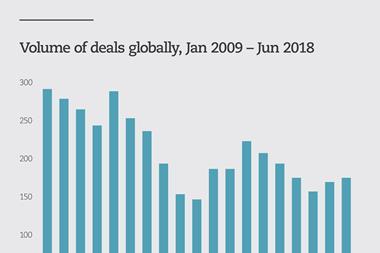Average policy limit as a percentage of deal size increased, while the cost of merger insurance fell, according to data from insurance broker JLT

The cost of insurance to cover mergers and acquisitions (M&A) deals has fallen 39% since 2015, according to insurance broker JLT Specialty.
Policy retentions fell to lowest ever levels and the average policy limit as a percentage of deal size increased, data from JLT’s fourth annual Global M&A Insurance Index revealed.
The insurance intermediary cited rising competition among commercial insurers as offsetting demand for deal covers.
JLT suggested the shift as signalling that clients prefer greater levels of protection and enhancements to their policy beyond the “standard” scope of warranty and indemnity (W&I) insurance.
Premium rates as a percentage of the limit purchased dropped from 1.87% in 2015 to 1.35% in 2016 to 1.15% in 2017.
That makes W&I insurance policies in transactions on average 15% cheaper last year than in 2016, and 39% cheaper than in 2015, JLT remarked.
Ben Crabtree, partner, M&A, JLT Specialty, said: “We have seen a material drop in the cost of M&A insurance policies over the last 24 months and our experience is that those insured have elected to increase protection rather than take the cost saving.
“It is rare in our experience for clients to ask us to focus on premium as their key requirement,” said Crabtree.
“At the outset we can give them comfort on costs based on our experience in the market and our data. Instead, our clients ask us to secure broader cover, tax specific cover and higher policy limits,” he added.
Policy retentions last year were 41% lower than 2016, according to JLT.
Real estate remains the sector with the lowest average policy retention at just 0.85% of the deal value – with insurers now giving options with nil retention structures if needed.
This means that clients can access policy payments from the first £1 of loss, JLT noted, subject only to the standard small claims thresholds that are always applied in sale agreements.
North America still accounts for most buyers, but Europe and other regions contributed 28% of deal size in 2017, up from 22% in 2015, observed JLT.
Insurance buyers in the UK and Asia purchased policy limits twice as high as their counterparts in the US and Northern Europe.
“This could be due to the variance in risk appetite but may also reflect that premium rates in both Asia and the UK have fallen considerably in 2017 – by 35% and 23% respectively,” said JLT.
The broker saw “a decisive shift” toward sellers being a driving force behind the introduction of W&I policies.
In 2017, 52% of sellers facilitated the introduction of such a policy as part of the deal (versus 48% of buyers).
Despite this, the numbers skewed towards buyers at deal closure, with 93% of policies in the buyer’s name.
The reason for this, JLT suggested, is that sellers are continuing to see W&I insurance as a means of securing a completely clean exit from a transaction.
A W&I policy gives the buyer protection and allows the seller to walk away following completion, JLT noted.
Crabtree said: “It is clear that insurance has become an integral part of the M&A transaction process, and that – with more insurers writing M&A insurance – there are solutions available whatever the underlying deal structure, jurisdiction or dynamic.
“The M&A market as a whole is embracing the use of these policies, as institutional investors, corporates, individuals and the full spectrum of the tax and M&A advisory community buy into how M&A insurance can be used to address risks in transactions,” he added.
Hosted by comedian and actor Tom Allen, 34 Gold, 23 Silver and 22 Bronze awards were handed out across an amazing 34 categories recognising brilliance and innovation right across the breadth of UK general insurance.



















































No comments yet